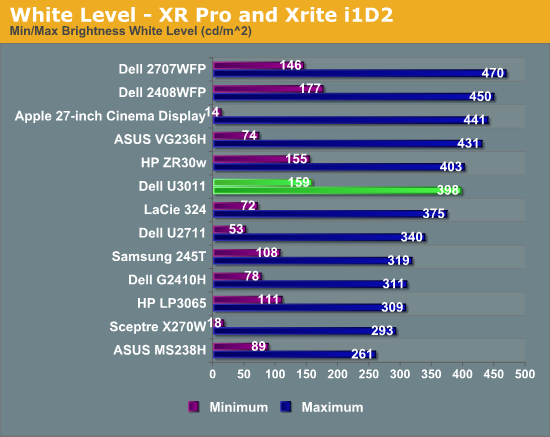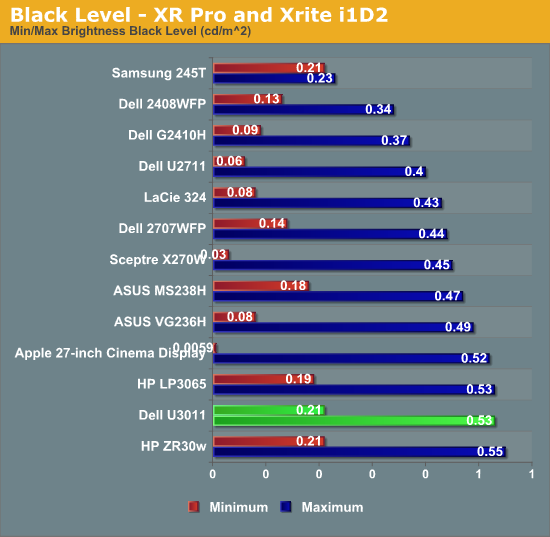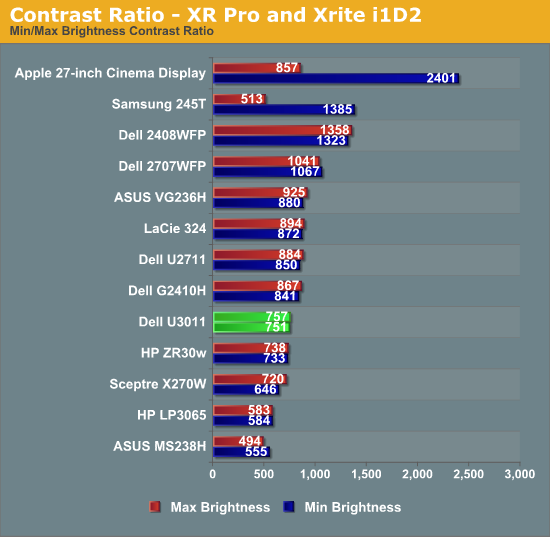Dell U3011 Review: Dell's New 30-inch Flagship
by Brian Klug on January 13, 2011 9:17 PM ESTBrightness and Contrast
For brightness we display white and black levels at maximum and minimum brightness as allowed by the OSD, and divide the two to get contrast. We use the same colorimeter described earlier. In this case, an Xrite i1D2 with ColorEyes Display Pro. For the U3011, dynamic contrast is turned off, contrast is set to maximum on the OSD, and the brightness control is varied across its possible dynamic range.



The brightness dynamic range on the U3011 isn't really amazing. In fact, it was a challenge to get the display to 100 nits for calibration (it required changing contrast and carefully balancing brightness and contrast controls on the OSD). One look at the contrast ratio plot however, and it's obvious what Dell did here - sacrifice dynamic range control for luminance but in so doing keep contrast extremely stable across that range of brightnesses. It's a tradeoff which actually makes a lot of sense, even if it isn't readily apparent when you're playing with the display, especially because the contrast OSD control visually makes a much larger difference than brightness which actually controls the CCFL power. I took a lot more data, but between max brightness and min brightness, contrast is pretty steady at around 750.
It's a bit unfortunate that the IPS in the U3011 isn't a bit more contrasty, especially when advertised is around 1000:1 with dynamic contrast off. Still, not bad.










123 Comments
View All Comments
CSMR - Friday, January 14, 2011 - link
High pixel pitch will increase legibility of text, and everything vector-based.Guspaz - Friday, January 14, 2011 - link
In terms of pricing from Dell themselves, I'm seeing the U2711 at $849 CAD, and the U3011 at $1599 CAD. Considering they offer the same class of resolution (2560xSomething, although I'd rather see 2560x1600 on the U2711, at least it's still 2560), a similar set of inputs, and the U2711 is a bit better in calibrated colour accuracy (and way better uncalibrated), it really looks to me like the U2711 is the better buy.Sabresiberian - Friday, January 14, 2011 - link
Same class of resolution? The pixel pitch on the 30" is .2505, the pixel pitch on the 27" is .233 - clearly a much tighter image. They aren't in the same resolution class by a long shot.I agree, I'd love to see a 2560x1600 .233 pixel pitch monitor - or better yet, a full 30",16:10 monitor with that pixel pitch. That would make my current 3-way conundrum - buy a U2711, a ZR30w, or wait for that 120Hz 30" monitor, a much easier decision. Especially if it were 120Hz. The dang 16:9 ratio of the U2711 is what makes it such a tough choice; I just don't want to support the industry using that format in any way - but I do want to throw in my vote for small pixel pitch as well as use a monitor with as fine a screen as I can get.
;)
Iketh - Saturday, January 15, 2011 - link
How are you supposed to get 2560x1600 .233 pitch on a 30" screen? That's physically impossible. May want to read up on what pixel pitch is, and the reason why a smaller screen with the same resolution will always have a lower pitch.adiposity - Sunday, January 16, 2011 - link
If you read his comment carefully, he didn't say that. He said either:a 2560x1600 @.233 pitch
or
a 30" 16:10 monitor with .233 pitch
Hrel - Friday, January 14, 2011 - link
Dang, look at those response times! No guitar hero being played on this thing.AnnonymousCoward - Saturday, January 15, 2011 - link
7ms GTG. How often does a PS3 refresh frames--24fps? That's 42ms.I'll give you the benefit of the doubt and assume you only play Guitar Hero on PC emulators with a CRT @ >140Hz.
aguilpa1 - Friday, January 14, 2011 - link
the OSD is the same as the Alienware 23" 120Hz LCD's, even copied the light up touch panel but went with blue instead of red. They may have considered the 120Hz option. Also the Optx 2310's have panel overdrive which mitigates the response time and removes the lag. I noticed on some reviews of the 2310's they are not doing this and reporting the panels have to much lag especially in 3D mode but if you set the panels to game mode and enable overdrive the visible lag problem goes away. I did that to all three of mine.MeanBruce - Friday, January 14, 2011 - link
Dude, It's the same OSD because Dell bought Alienware a few years back. Same design group. Pretty sure all the 24in panels Dell/Alienware are assembled in the same little factory in Meheeco.aguilpa1 - Friday, January 14, 2011 - link
yup I know this, I was just saying, when I ordered my three 2310's they were from Dell. On a panel that is supposed to be their flagship they should have also stole the quality of design, the 120Hz, the overdrive engine and not just the OSD from the 2310's.